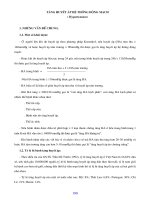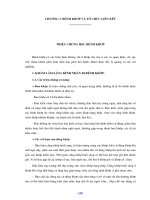GIÁO TRÌNH MARKETING NGHIÊN CỨU - PHẦN 12 pot
Bạn đang xem bản rút gọn của tài liệu. Xem và tải ngay bản đầy đủ của tài liệu tại đây (457.27 KB, 41 trang )
Determining How to
Select a Sample
Ch 12 2
Basic Concepts in Sampling
•
Population: the entire group under
study as defined by research
objectives
–
Researchers define populations in
specific terms such as “heads of
households located in areas
served by the company who are
responsible for making the pest
control decision.”
Ch 12 3
Basic Concepts in Sampling
•
Sample: a subset of the population
that should represent the entire
group
•
Sample unit: the basic level of
investigation
•
Census: an accounting of the
complete population
Ch 12 4
Basic Concepts in Sampling
•
Sampling error: any error in a survey
that occurs because a sample is used
•
A sample frame: a master list of the
entire population
•
Sample frame error: the degree to
which the sample frame fails to
account for all of the population…a
telephone book listing does not
contain unlisted numbers
Ch 12 5
Reasons for Taking a Sample
•
Practical considerations such as
cost and population size
•
Inability of researcher to analyze
huge amounts of data generated
by census
•
Samples can produce precise
results
Ch 12 6
Two Basic Sampling Methods
•
Probability samples: ones in which
members of the population have a
known chance (probability) of
being selected into the sample
•
Non-probability samples:
instances in which the chances
(probability) of selecting members
from the population into the
sample are unknown
Ch 12 7
Probability Sampling Methods
•
Simple random sampling
•
Systematic sampling
•
Cluster sampling
•
Stratified sampling
Ch 12 8
Probability Sampling Methods
Ch 12 9
Probability Sampling:
Simple Random Sampling
•
Simple random sampling: the
probability of being selected into
the sample is “known” and equal
for all members of the population
–
E.g., Blind Draw Method
–
Random Numbers Method (see
MRI 12.1, p. 335)
Ch 12 10
Probability Sampling:
Simple Random Sampling
–
Advantage:
•
Known and equal chance of selection
–
Disadvantages:
•
Complete accounting of population
needed
•
Cumbersome to provide unique
designations to every population
member
Ch 12 11
Probability Sampling
Systematic Sampling
•
Systematic sampling: way to
select a random sample from a
directory or list that is much more
efficient than simple random
sampling
–
Skip interval=population list
size/sample size
Ch 12 12
Probability Sampling
Systematic Sampling
–
Advantages:
•
Approximate known and equal
chance of selection…it is a probability
sample plan
•
Efficiency…do not need to designate
every population member
•
Less expensive…faster than SRS
–
Disadvantage:
•
Small loss in sampling precision
Ch 12 13
Probability Sampling
Cluster Sampling
•
Cluster sampling: method in
which the population is
divided into groups, any of
which can be considered a
representative sample
–
Area sampling
Ch 12 14
Probability Sampling
Cluster Sampling
–
Advantage:
•
Economic efficiency…faster and
less expensive than SRS
–
Disadvantage:
•
Cluster specification error…the
more homogeneous the clusters,
the more precise the sample
results
Ch 12 15
Cluster Sampling
•
In cluster sampling the population
is divided into subgroups, called
“clusters.”
•
Each cluster should represent the
population.
•
Area sampling is a form of cluster
sampling – the geographic area is
divided into clusters.
Ch 12 16
Cluster Sampling
•
One cluster may be selected to
represent the entire area with the
one-step area sample.
•
Several clusters may be selected
using the two-step area sample.
Ch 12 17
A Two-Step Cluster Sample
•
A two-step cluster sample
(sampling several clusters) is
preferable to a one-step (selecting
only one cluster) sample unless
the clusters are homogeneous.
Ch 12 18
Stratified Sampling
•
When the researcher knows the
answers to the research question
are likely to vary by subgroups…
Ch 12 19
Stratified Sampling
–
Research Question: “To what extent
do you value your college degree?”
Answers are on a five point scale: 1=
“Not valued at all” and 5= “Very
highly valued”
•
We would expect the answers to vary
depending on classification. Freshmen
are likely to value less than seniors.
We would expect the mean scores to
be higher as classification goes up.
Ch 12 20
Stratified Sampling
–
Research Question: “To what extent
do you value your college degree?”
•
We would also expect there to be more
agreement (less variance) as
classification goes up. That is, seniors
should pretty much agree that there is
value. Freshmen will have less
agreement.
Ch 12 21
Stratified Sampling
Ch 12 22
Probability Sampling
Stratified Sampling
•
Stratified sampling: method in
which the population is separated
into different strata and a sample
is taken from each stratum
–
Proportionate stratified sample
–
Disproportionate stratified sample
Ch 12 23
Probability Sampling
Stratified Sampling
–
Advantage:
•
More accurate overall sample of
skewed population…see next slide for
WHY
–
Disadvantage:
•
More complex sampling plan
requiring different sample size for
each stratum
Ch 12 24
Stratified Sampling
•
Why is stratified sampling more
accurate when there are skewed
populations?
–
The less variance in a group, the less
sample size it takes to produce a
precise answer.
–
Why? If 99% of the population (low
variance) agreed on the choice of Brand
A, it would be easy to make a precise
estimate that the population preferred
Brand A even with a small sample size.
Ch 12 25
Stratified Sampling
–
But, if 33% chose Brand A, and
23% chose B, and so on (high
variance) it would be difficult to
make a precise estimate of the
population’s preferred brand…it
would take a larger sample size…









